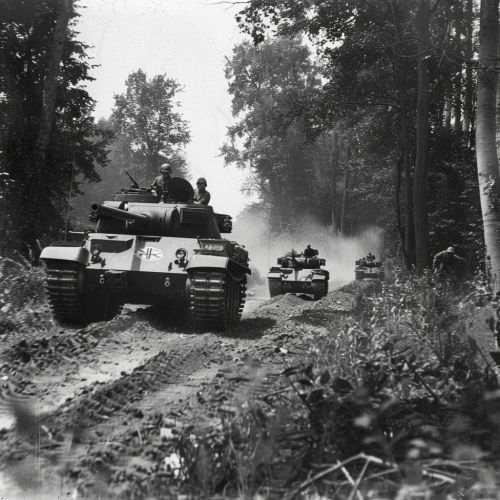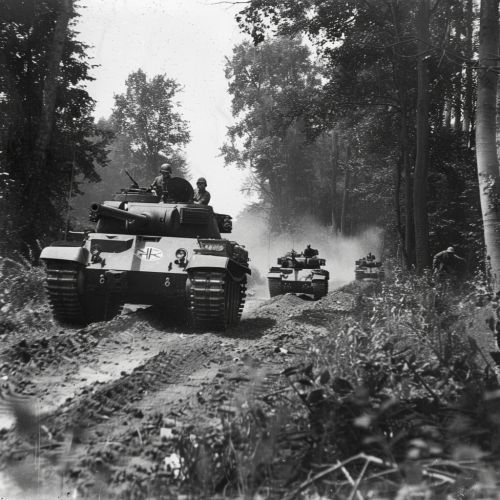Western Front (World War II)
Western Front (World War II)
The Western Front of World War II, which spanned from 1939 to 1945, was a crucial theater of conflict between the Allies and the Axis powers. This front saw some of the most significant and intense battles of the war, including the invasion of France, the Battle of Britain, the Normandy landings, and the Battle of the Bulge. The Western Front was primarily fought in Western Europe and involved major military operations by the United States, the United Kingdom, Canada, and other Allied nations against Nazi Germany.
Prelude to Conflict
The origins of the Western Front in World War II can be traced back to the Treaty of Versailles, which ended World War I but left Germany with significant grievances. The rise of Adolf Hitler and the Nazi Party in the 1930s, along with their aggressive expansionist policies, set the stage for renewed conflict. The invasion of Poland by Germany on September 1, 1939, led to the declaration of war by the United Kingdom and France, marking the beginning of World War II.
The Phoney War
The initial phase of the Western Front is often referred to as the "Phoney War" or "Sitzkrieg," lasting from September 1939 to May 1940. During this period, there was little actual combat on the Western Front, as both sides prepared for the inevitable conflict. The Allies fortified their positions along the Maginot Line, a series of defensive fortifications along the French-German border, while the Germans planned their next moves.
Invasion of France and the Low Countries
In May 1940, Germany launched a blitzkrieg, or "lightning war," against France and the Low Countries. The German forces, utilizing rapid and coordinated attacks by tanks, infantry, and aircraft, quickly overwhelmed the defenses of Belgium, the Netherlands, and Luxembourg. The main thrust of the German attack, known as the Manstein Plan, bypassed the heavily fortified Maginot Line by advancing through the Ardennes Forest, a region considered impassable by the Allies.


The German advance trapped the British Expeditionary Force (BEF) and French forces in a pocket around Dunkirk. In a remarkable evacuation effort, known as Operation Dynamo, over 330,000 Allied soldiers were evacuated from Dunkirk to Britain between May 26 and June 4, 1940. Despite this successful evacuation, France fell to the Germans, and an armistice was signed on June 22, 1940, leading to the occupation of northern France and the establishment of the Vichy regime in the south.
Battle of Britain
Following the fall of France, Germany turned its attention to Britain. The Battle of Britain, fought between July and October 1940, was the first major military campaign fought entirely by air forces. The German Luftwaffe aimed to gain air superiority over the Royal Air Force (RAF) as a prelude to a planned invasion of Britain, codenamed Operation Sea Lion.
The RAF, utilizing radar technology and the strategic advantages of fighting over home territory, successfully repelled the German air assaults. The resilience of the British pilots and the effective coordination of air defenses led to a significant defeat for the Luftwaffe, marking the first major German setback of the war.
The Atlantic Wall and Occupied Europe
With the failure to subdue Britain, Germany fortified its positions along the western coast of Europe, constructing the Atlantic Wall, a series of coastal defenses stretching from Norway to the Spanish border. These fortifications were intended to repel any Allied invasion attempts.
Occupied Europe experienced harsh German rule, with widespread repression, forced labor, and the implementation of the Holocaust. Resistance movements emerged across occupied territories, conducting sabotage, intelligence gathering, and guerrilla warfare against German forces.
Planning the Invasion of Normandy
The Allies began planning a return to the continent, culminating in Operation Overlord, the codename for the invasion of Normandy. The planning involved extensive coordination among the Allied nations, including the United States, the United Kingdom, and Canada. The operation aimed to establish a foothold in France and begin the liberation of Western Europe.
Key to the success of the invasion was the deception plan, Operation Bodyguard, which aimed to mislead the Germans about the location and timing of the invasion. The Allies used a variety of tactics, including fake radio transmissions, dummy equipment, and double agents, to convince the Germans that the invasion would occur at Pas de Calais rather than Normandy.
D-Day: The Normandy Landings
On June 6, 1944, D-Day, the Allies launched the largest amphibious invasion in history. Over 156,000 troops landed on five beachheads in Normandy: Utah, Omaha, Gold, Juno, and Sword. The landings were preceded by extensive aerial and naval bombardments and were supported by airborne operations that dropped paratroopers behind enemy lines.
Despite fierce German resistance, particularly at Omaha Beach, the Allies succeeded in securing the beachheads. The establishment of a foothold in Normandy allowed the Allies to begin the liberation of France. The subsequent Battle of Normandy saw intense fighting as the Allies pushed inland, culminating in the liberation of Paris on August 25, 1944.
The Liberation of Western Europe
Following the success in Normandy, the Allies advanced rapidly across Western Europe. The liberation of Belgium and the Netherlands followed, with key battles such as the Battle of the Scheldt and Operation Market Garden, an ambitious but ultimately unsuccessful attempt to secure a rapid advance into Germany.
The German counteroffensive in the Ardennes, known as the Battle of the Bulge, was the last major German offensive on the Western Front. Launched in December 1944, the surprise attack aimed to split the Allied forces and capture the vital port of Antwerp. Despite initial successes, the Allies regrouped and repelled the German advance by January 1945.
The Final Push into Germany
With the failure of the Ardennes offensive, the Allies resumed their advance into Germany. The crossing of the Rhine River in March 1945, particularly at Remagen, marked a significant milestone. The Allies then advanced rapidly into the heart of Germany, encountering fierce resistance but steadily pushing forward.
The Western Front saw the liberation of concentration camps, the discovery of the horrors of the Holocaust, and the eventual link-up with Soviet forces advancing from the east. The capture of Berlin by the Soviets in May 1945 and the subsequent German surrender on May 8, 1945, marked the end of the war in Europe.
Aftermath and Legacy
The Western Front of World War II had a profound impact on the course of the war and the post-war world. The liberation of Western Europe paved the way for the establishment of democratic governments and the reconstruction of war-torn nations. The experiences and lessons learned from the Western Front influenced military strategy, international relations, and the development of institutions such as the United Nations and NATO.
The Western Front remains a significant area of study for historians and military scholars, offering insights into the complexities of modern warfare, the importance of international cooperation, and the resilience of nations in the face of adversity.
